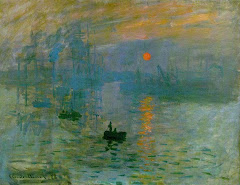Abstract art:
Any art in which the depiction of real objects in nature has been subordinated or entirely discarded, and whose aesthetic content is expressed in formal pattern or structure of shapes, lines,and colors. Sometimes the subject is real but so stylized, blurred, repeated, or broken down into basic forms as to be unrecognizable.
Source: http://www.khsd.k12.ca.us/bhs/Perry/art%20vocabulary.htm
Peinture non figurative :
L’art non-figuratif ne représente rien que l'on puisse reconnaître, contrairement aux représentations de la réalité. On emploie également le mot abstrait. L’art abstrait (ou l'abstraction) est une forme d'expression artistique au même titre que l'art figuratif (ou la figuration). Il apparaît au début du XXe siècle, avec l'art moderne, et constitue encore un pan important de l'art contemporain.
Source :http://www.ac-reunion.fr/pedagogie/ArtsPlastiques/glossaire/Index-artpla-gloss3.htm
Paintings :
Color paint applied by hand to a surface (support) such as paper, canvas, wood, glass, or other.
Source: http://memory.loc.gov/ammem/techdocs/genre.html
Peinture :
Dans un sens artistique, le terme « peinture » signifie la combinaison de cette activité avec le dessin, la composition, c'est-à-dire qu'il intègre des considérations esthétiques.
Source : fr.wikipedia.org/wiki/Peinture
Museum :
A building, place or institution devoted to the acquisition, conservation, study, exhibition and educational interpretation of objects having scientific, historical or artistic value. The word Museum is derived from the Latin muses, meaning "a source of inspiration," or "to be absorbed in one's thoughts."
Source: http://www.artefoundation.com/pages/glossary.html
Musées :
C'est le lieu de conservation et de présentation des oeuvres d'art. Il est le lieu irremplaçable où l'on peut voir et revoir les collections permanentes. Il est aussi le lieu où l'on peut découvrir des expositions temporaires provenant d'autres musées ou de collections privées. La création des musées publics remonte pour l'essentiel à la fin du XVIIIe siècle. En France, l'un des plus connus est certainement le musée du Louvre, à Paris. Son ouverture date de 1793. Le musée a considérablement évolué depuis son origine jusqu'à nos jours. Il concentre de plus en plus salles de conférences, bibliothèques et autres services destinés à mettre en valeur les oeuvres et apporter le maximum d'informations aux visiteurs
Source :http://www.ac-reunion.fr/pedagogie/ArtsPlastiques/glossaire/Index-artpla-gloss2.htm
Thesaurus :
A list of subject headings or descriptors assigned in a particular database, index, or online catalog that can be used to search that database.
Source: http://www.peabody.jhu.edu/1437
Thesaurus :
Langage documentaire fondé sur une structuration hiérarchisée d'un ou plusieurs domaines de la connaissance et dans lequel les notions sont représentées par des termes d'une ou plusieurs langues naturelles et les relations entre notions par des signes conventionnels.
Source : http://www.ebsi.umontreal.ca/termino/00000240.htm
Work of art :
Work of art that is a product of one of the fine arts (especially a painting or sculpture of artistic merit).
Source: http://wordnet.princeton.edu/perl/webwn?s=work%20of%20art
Œuvre d’art :
Une œuvre d'art est un objet purement humain, d'êtres capables de sensibilité, et qui tentent de représenter dans des formes et des structurations d'éléments interagissant une perception construite, réelle ou transcendante
Source : http://fr.wikipedia.org/wiki/%C5%92uvre_d%27art
Multimedia :
Writing and filmmaking encompassing more than one medium at a time which, script-wise, usually refers to CD-ROM games or Internet-based programming.
Source: http://www.screenwriting.info/glossary.php
Multimedia :
Documents ou systèmes caractérisés par l¹intégration de textes, d¹images fixes et en mouvement, et de sons. Comme ces éléments constituent une très grosse part de la documentation et des systèmes actuels, la pertinence de ce terme pour désigner une catégorie spéciale de documents et de systèmes est remise en question.
Source : http://www.ebsi.umontreal.ca/termino/00000173.htm
Content analysis:
A set of procedures for collecting and organizing nonstructured information into a standardized format that allows one to make inferences about the characteristics and meaning of written and otherwise recorded material.
Source: http://www.ojp.usdoj.gov/BJA/evaluation/glossary/glossary_c.htm
Analyse documentaire:
Processus de description du contenu thématique d'un document. Comporte deux phases distinctes : 1) perception du contenu, 2) représentation formalisée du contenu. On distingue trois niveaux d'analyse et de représentation : 1) la classification (général), 2) la condensation (description verbale), 3) l'indexation (spécifique).
Source: http://ecolebibdoc.blogs.com/dossier_documentaire_docu/2006/11/lexique.html
Indexing:
The process of converting a collection of data into a database suitable for easy search and retrieval.
Source: http://cavalierwebsolutions.com/seoglossary.html
Indexation:
Processus destiné à représenter par les éléments d'un langage documentaire ou naturel des données résultant de l'analyse du contenu d'un document ou d'une question. On désigne également ainsi le résultat de cette opération (AFNOR 1987).
Source: http://www.bibliotheques.uqam.ca/bibliotheques/serv_techniques/analyse/politiques/POL_glossaire.HTML



